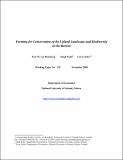| dc.contributor.author | van Rensburg, Thomas | en |
| dc.contributor.author | Kelley, Hugh | en |
| dc.contributor.author | Yadav, Lava | en |
| dc.date.accessioned | 2010-06-04T15:03:17Z | en |
| dc.date.available | 2010-06-04T15:03:17Z | en |
| dc.date.issued | 2009-11 | en |
| dc.identifier.citation | van Rensburg, T., Kelley, H., & Yadav, L. (2009). "Farming for Conservation of the Upland Landscape and Biodiversity in the Burren" (No. 0153): School of Economics, National University of Ireland, Galway. | en |
| dc.identifier.uri | http://hdl.handle.net/10379/1140 | en |
| dc.description.abstract | The Burren landscape which stands out as one of the most magnificent managed landscapes in all of Europe has recently come under threat due to a shift in farm management practices. As a result of evolving market trends and social structures, traditional farming methods are being replaced by more conventional/commercial practices and in some cases a gradual abandonment of the lands for off farm income sources is occurring. Agri-environmental schemes such as the Rural Environmental Protection Scheme (REPS) with its generic farm management prescriptions have not proved to be effective in conserving this landscape along with its natural and cultural values.
The BurrenLIFE initiative which has been experimenting on 20 farms over the last five years have targeted their efforts specifically on the Burren region to find the best scientific practices required for farming for conservation. In this study we investigate whether the farming practices recommended by BurrenLIFE project (BLP) are economically viable in providing a desirable public good. This work employs a survey based valuation technique (Choice Experiments) as well as a relatively new valuation approach (using a prediction technique) to estimate the value of some of the positive externalities generated by the BurrenLIFE management practices. Along with the positive externalities, the multiplier effect related to tourism is estimated and incorporated into a Land Portfolio Allocation (LPA) model to examine the effect of various policies and subsidies on the farming practices of the 20 BurrenLIFE farms (¿Burren 20 farms¿).
Our results indicate that even with the most conservative reported willingness to pay from survey data, the rate of return on government support for these systems is no less than 235%. However, we also find that these farming practices are sensitive to the various government and BurrenLIFE subsidies to the farms; thus highlighting the importance of these payments in encouraging farmers to farm for conservation. | en |
| dc.format | application/pdf | en |
| dc.language.iso | en | en |
| dc.publisher | National University of Ireland, Galway | en |
| dc.relation.ispartofseries | Economics Working Papers;0153 | en |
| dc.rights | Attribution-NonCommercial-NoDerivs 3.0 Ireland | |
| dc.rights.uri | https://creativecommons.org/licenses/by-nc-nd/3.0/ie/ | |
| dc.subject | Economics | en |
| dc.title | Farming for Conservation of the Upland Landscape and Biodiversity in the Burren | en |
| dc.type | Working Paper | en |
| dc.description.peer-reviewed | peer-reviewed | en |
| nui.item.downloads | 1447 | |


